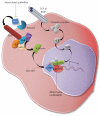Targeting the mechanisms of resistance to chemotherapy and radiotherapy with the cancer stem cell hypothesis
- PMID: 20981352
- PMCID: PMC2958340
- DOI: 10.1155/2011/941876
Targeting the mechanisms of resistance to chemotherapy and radiotherapy with the cancer stem cell hypothesis
Abstract
Despite advances in treatment, cancer remains the 2nd most common cause of death in the United States. Poor cure rates may result from the ability of cancer to recur and spread after initial therapies have seemingly eliminated detectable signs of disease. A growing body of evidence supports a role for cancer stem cells (CSCs) in tumor regrowth and spread after initial treatment. Thus, targeting CSCs in combination with traditional induction therapies may improve treatment outcomes and survival rates. Unfortunately, CSCs tend to be resistant to chemo- and radiation therapy, and a better understanding of the mechanisms underlying CSC resistance to treatment is necessary. This paper provides an update on evidence that supports a fundamental role for CSCs in cancer progression, summarizes potential mechanisms of CSC resistance to treatment, and discusses classes of drugs currently in preclinical or clinical testing that show promise at targeting CSCs.
Figures





Similar articles
-
Resistance to Cell Death and Its Modulation in Cancer Stem Cells.Crit Rev Oncog. 2016;21(3-4):203-219. doi: 10.1615/CritRevOncog.2016016976. Crit Rev Oncog. 2016. PMID: 27915972 Free PMC article. Review.
-
Cancer stem cells in drug resistant lung cancer: Targeting cell surface markers and signaling pathways.Pharmacol Ther. 2016 Feb;158:71-90. doi: 10.1016/j.pharmthera.2015.12.001. Epub 2015 Dec 17. Pharmacol Ther. 2016. PMID: 26706243 Review.
-
CSC Radioresistance: A Therapeutic Challenge to Improve Radiotherapy Effectiveness in Cancer.Cells. 2020 Jul 9;9(7):1651. doi: 10.3390/cells9071651. Cells. 2020. PMID: 32660072 Free PMC article. Review.
-
Stem cell programs in cancer initiation, progression, and therapy resistance.Theranostics. 2020 Jul 9;10(19):8721-8743. doi: 10.7150/thno.41648. eCollection 2020. Theranostics. 2020. PMID: 32754274 Free PMC article. Review.
-
Targeting head and neck tumoral stem cells: From biological aspects to therapeutic perspectives.World J Stem Cells. 2016 Jan 26;8(1):13-21. doi: 10.4252/wjsc.v8.i1.13. World J Stem Cells. 2016. PMID: 26839637 Free PMC article. Review.
Cited by
-
Effects of curcumin on stem-like cells in human esophageal squamous carcinoma cell lines.BMC Complement Altern Med. 2012 Oct 24;12:195. doi: 10.1186/1472-6882-12-195. BMC Complement Altern Med. 2012. PMID: 23095512 Free PMC article.
-
Targeting Liver Cancer Stem Cells: An Alternative Therapeutic Approach for Liver Cancer.Cancers (Basel). 2020 Sep 24;12(10):2746. doi: 10.3390/cancers12102746. Cancers (Basel). 2020. PMID: 32987767 Free PMC article. Review.
-
Harnessing the apoptotic programs in cancer stem-like cells.EMBO Rep. 2015 Sep;16(9):1084-98. doi: 10.15252/embr.201439675. Epub 2015 Aug 7. EMBO Rep. 2015. PMID: 26253117 Free PMC article. Review.
-
CD44 Expression Predicts Prognosis of Ovarian Cancer Patients Through Promoting Epithelial-Mesenchymal Transition (EMT) by Regulating Snail, ZEB1, and Caveolin-1.Front Oncol. 2019 Aug 21;9:802. doi: 10.3389/fonc.2019.00802. eCollection 2019. Front Oncol. 2019. PMID: 31497537 Free PMC article.
-
Cardamonin, a natural chalcone, reduces 5-fluorouracil resistance of gastric cancer cells through targeting Wnt/β-catenin signal pathway.Invest New Drugs. 2020 Apr;38(2):329-339. doi: 10.1007/s10637-019-00781-9. Epub 2019 May 17. Invest New Drugs. 2020. PMID: 31102118
References
-
- Gianni L, Eiermann W, Semiglazov V, et al. Neoadjuvant chemotherapy with trastuzumab followed by adjuvant trastuzumab versus neoadjuvant chemotherapy alone, in patients with HER2-positive locally advanced breast cancer (the NOAH trial): a randomised controlled superiority trial with a parallel HER2-negative cohort. The Lancet. 2010;375(9712):377–384. - PubMed
-
- Spielmann M, Roché H, Delozier T, et al. Trastuzumab for patients with axillary-node-positive breast cancer: results of the FNCLCC-PACS 04 trial. Journal of Clinical Oncology. 2009;27(36):6129–6134. - PubMed
-
- Penson RT, Dizon DS, Cannistra SA, et al. Phase II study of carboplatin, paclitaxel, and bevacizumab with maintenance bevacizumab as first-line chemotherapy for advanced Müllerian tumors. Journal of Clinical Oncology. 2010;28(1):154–159. - PubMed
LinkOut - more resources
Full Text Sources
Other Literature Sources

